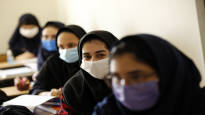Iranian authorities suspect that the aim of the poisoning may be to close girls’ schools.
Hundreds of girls and young Iranian women from a total of 30 schools have been hospitalized due to suspected poisoning.
During the last three months, at least 1,200 students have suffered from the symptoms of poisoning. The number of poisoned girls is estimated to be up to 2,000.
Intentional poisoning is suspected as the cause of the respiratory symptoms.
On Thursday, the Iranian authorities arrested four people who are suspected of being involved in the poisoning of schoolgirls, reports the AFP news agency.
The arrests are related to the beating of a woman in front of a girls’ school in the capital, Tehran. The school had been poisoned just before the assault. A video of the abuse spread on social media, and AFP has verified the authenticity of the video.
The UN has demanded that Iran conduct a comprehensive and transparent investigation into the suspected poisoning of hundreds of schoolgirls.
Germany also demands that Iran investigate the cases, the news agencies Reuters and AFP report. The foreign minister of the country Annalena Baerbockin according to the information about the poisoning of schoolgirls is shocking. He reminded that girls have the right to go to school without fear.
Cases of poisoning in different parts of the country
Based on media reports, at least ten girls’ schools were poisoned last Wednesday.
The first reported poisonings occurred in the city of Qom in Tehran province on November 30.
Due to poisoning symptoms, students from Borujerdin schools have been admitted to the hospital last week.
In addition, in the province of Lorestan, at least 194 girls from four schools have had to be hospitalized due to poisoning symptoms during the past week.
News channel CNN (switch to another service) says Iranian state media have also reported at least one case of poisoning at a boys’ school in Qom in February.
Iran’s Minister of Health Bahram Einollahi says that according to a report by the Iranian Students News Agency, the poisoning symptoms have been mild so far. Several samples have been taken from poisoned patients brought to the Qom hospital, in which no microbes or viruses have been detected, according to the data.
According to Einollah, those exposed to the poison have suffered from muscle weakness, nausea and fatigue.
Who is behind the poisonings?
Local authorities believe that the attacks are a means to force girls out of schools and to have girls’ schools closed entirely.
Iran’s Deputy Minister of Health for Research and Technology Younes Panahi said in February that the poisonings were chemical, but not the compound chemicals used in the war. According to Panah, the symptoms have not been contagious.
Activists have compared attacks on Iranian schools to terrorism against women by the Afghan Taliban and Nigeria’s Boko Haram.
Both extremist organizations oppose girls’ education.
Several girls have had to stay out of school due to cases of poisoning.
In the background, the scarf protests of last fall
Many students believe the poisoning attacks are revenge for their participation in recent anti-government protests.
Last September, widespread protests broke out in the country when the 22-year-old Mahsa Amini died at the hands of the chastity police. It is said that Amini was initially targeted by the chastity police because of a scarf worn incorrectly.
In protest against the authorities’ violence, thousands of women defied the headscarf requirement and cut their hair in the streets.
In October, female students at several educational institutions took off their headscarves to protest Amin’s death.
